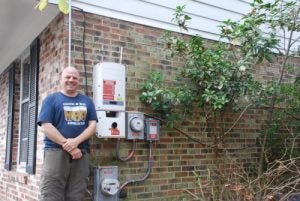How a new smart inverter standard paves way for more solar


Solar panel systems, like any piece of electronic equipment, must meet commonly accepted operating standards. The Institute of Electrical and Electronic Engineers (IEEE) develops these standards. The organization recently published a new standard (IEEE 1547-2018) for solar inverters that will ensure homeowners can continue to go solar without negatively impacting the broader electric grid. The new standard may also allow for solar homeowners to better monetize the benefits their systems provide to the electric grid.
What is an inverter?
Solar inverters are the part of your system that change the direct current (DC) produced by your solar panels into alternating current (AC) that is used by your home and appliances. Inverters also control how the electricity flows out of your system onto the electric grid. Under the current standard (IEEE 1547-2003), inverters will not output electricity if the voltage and frequency of the electric grid is outside of normal ranges. This may happen when the grid is under stress, such as too many people using electricity at once unexpectedly or if parts of the system are damaged from a storm or other event.
When the inverter sees that the grid has returned to normal, the current standard requires it to wait a few minutes before starting up again. This prevents the inverter from sending electrical current into the grid when the grid isn’t behaving normally or is down. This keeps grid maintenance workers safe from electricity flowing through the transmission lines they may be repairing.
Inverters: gatekeepers to the electricity grid
Having rooftop solar systems all turn off at the same time can create challenges for grid operators in places where there is a high concentration of solar. In Hawaii, for example, 31% of single family detached structures have a solar array. When there is an event of grid instability, the current standard turns off all local solar production while the inverters wait to turn back on. Grid operators need to supply that electricity from somewhere else. The new standard allows grid operators to set specifications for inverter behavior that lessen this challenge. The new standard makes the inverters more tolerant of grid signal fluctuations, so they maintain their electricity production and directly participate in keeping the grid stable and reliable while still making sure inverters shut off for outages, keeping line workers safe.
A new, smarter inverter
The new standard also has requirements for inverters to support communications protocols for active coordination with the grid. Over time, these communications protocols, and the rules set by utility commissions for their use, could enable grid operators and possibly third-party providers to deliver valuable grid services. This could include temporarily reducing or boosting energy production or changing the electrical characteristics of the energy the inverters produce to help keep the grid in balance. This would enable an individual solar array and its inverter to become even more valuable to its owner and to the utility because it would play an active part in the constant supervision and attention the electricity grid requires to stay operating twenty-four hours a day, seven days a week, 365 days a year. Regulators will need to decide what economic value these new services have and who is allowed to capture that value. Some states, such as Minnesota and Maryland, have begun this conversation.
The new standard is to be fully implemented by 2021-2022. Solar inverters that support IEEE 1547-2018 will be widely available on the market across the United States. Policymakers at utility commissions around the country will need to examine their rules for connecting solar to the grid. These regulators must work with grid operators and other stakeholders to ensure these new standards deliver the maximum benefit and support solar market growth.
For a technical dive into the new standard check out this Interstate Renewable Energy Council (IREC) report.
